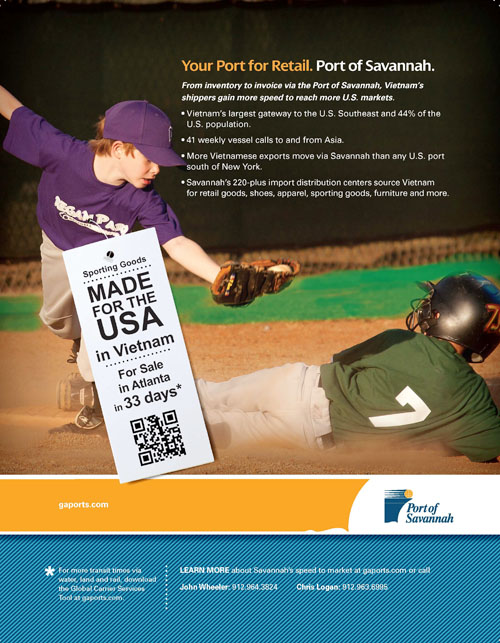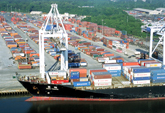The boy may be an American but his baseball mitt was made in Vietnam. It made its way to him in Atlanta from Cai Mep via the Port of Savannah on one of the growing number of services connecting Vietnam to this port city on the Southeastern coast of Georgia. Indeed the fastest growing and fourth largest port in the U.S., the Georgia Ports Authority (GPA), is now increasingly playing a larger role in U.S.A. trade with Vietnam. Recently, GPA’s Port of Savannah announced the beginning of the South China/Vietnam/Savannah (SVS) Service. This U.S.A. East Coast service connects Cai Mep (HCM) with Savannah in 34 days. Its carriers consist of APL, Evergreen, Hyundai Merchant Marine, and Mitsui OSK Lines.

Made for the USA in Vietnam
In addition to the SVS, the Port of Savannah is connected to Vietnam via the Grand Alliance’s AEX service, with transit times from Cai Mep to Savannah of 32 days. Its carriers consist of Hapag Lloyd, NYK, and OOCL. Further, the CKYH Group’s AWE4 service has a travel time to Cai Mep from Savannah of 27 days; its participants are K-Line, Cosco, Hanjin, Yang Ming, and MOL. The development of these services is ably supported by Bui Quang Hung and Amy Thanh who, through Barwil Sunnytrans Company Ltd., who represent that Port of Savannah in HCM City.
The Port of Savannah has long been the dominant Southeast U.S.A. port for trade with Asia, with Asia accounting for nearly 70% of its total trade. It is also the dominant Southeast port in Vietnam market share. In CY 2011, Savannah had 41% market share of the Southeast’s trade with Vietnam – nearly double the second largest player in the Vietnam market (Norfolk).
As exporters to the U.S.A. continue to diversify manufacturing beyond China, Vietnam is well-positioned to seize even more of this trade. “We are very focused on Southeast Asia and have been for a long time,” notes John Wheeler, GPA’s Senior Director for Trade Development. “While much of the Savannah-Vietnam trade is consumer goods imports to the U.S.A., Vietnam’s growing middle class is also fueling its increased imports from our port,” adds Wheeler.
Dominating Vietnam’s exports to Savannah in CY 2011 were furniture, wearing apparel, toys, coffee, machinery & electronics, iron & steel, rubber, and frozen seafood. Among those, the fastest growing commodities in CY 2011 were footware, which rose 91%, machinery and electronics, which jumped 112%, and frozen fish, which increased 61%.
On the Vietnam import side from Savannah were frozen poultry, lumber, wood pulp, fabrics, animal feed, paper, construction building equipment, and nuts. The fastest growing in that group in CY 2011 were wood pulp, which rose 104%, animal feed, which gained nearly 550%, and nuts, up 100%. In an interesting switch, GPA is exporting kraft linerboard to Vietnam, which is then shipped back as the consumer packaging for goods being imported into the U.S.A.
The Southeast U.S.A. is the fastest growing part of the country in terms of population and investment. Increasingly, this is making the Port of Savannah, which is located in the heart of the Southeast, vital for both shipping lines and BCOs (beneficial cargo owners). “We’ve become the U.S. Southeast’s primary gateway for about 44 percent of the U.S. population,” says Curtis Foltz, Executive Director of the GPA. “It’s all part of our focus and goal to be the logistics center of the Southeast,” says Foltz.
Indeed that is already happening. The Georgia Ports Authority is the second biggest port on the East Coast after the Port of New York/New Jersey. As an interesting fact, the combined population of the Southeast states of Florida and Georgia is now larger than the combined population of New York and New Jersey. The shipping lines are aware of this population shift and it is a big factor in GPA’s growth. The Port of Savannah now offers 40 weekly services covering the globe, the most significant portion of which are with Asia.
Several of the largest carriers plying the Savannah-Vietnam tradelane have seen their numbers grow in CY 2011. Evergreen’s Savannah-Vietnam trade grew 146% and the new SVS service will boost their trade even more. Hapag-Lloyd’s trade grew 85% with the help of the AEX service. Zim also saw a 23% increase in the past year.
Part of the Port of Savannah’s appeal comes from the unique features of its Garden City Terminal that set it apart from other U.S.A terminals. It is the only U.S.A. terminal with two on-terminal rail, which connects it more rapidly with rail hubs in Atlanta, Orlando, Charlotte, Dallas and beyond. It is also the largest single terminal in the country, at 485.6 ha (1200 acres), and operating just one massive contiguous container port offers many efficiencies.
The Port of Savannah is also unique in that it is almost exactly evenly balanced between imports and exports, a rarity among U.S.A. ports. Ocean carriers benefit because after bringing import containers to Savannah, their vessels don’t leave empty and can load export. Shippers benefit because more equipment is available in places where imports and exports are balanced.
While these advantages have not gone unnoticed, another crucial factor is the port’s reputation as “Port Retail.” The port got this nickname because of its myriad retail distribution centers located around the port. Over 20 distribution centers are within a few miles of the port and 200 more are within a four-hour-drive. For example, IKEA and Pier 1, both among the top 10 BCO exporters from Vietnam to Savannah, have distribution centers within minutes of the Port of Savannah.
Other BCOs in the top ten exporting from Vietnam to Savannah include Rooms To Go, Bassett Furniture (up 207% in 2011), Big Lots (up over 1000% in 2011), and General Electric (up nearly 290% in 2011). PVH Corporation and Disney are also major exporters.
On the import side from Savannah to Vietnam, the list of the top importers includes Weyerhaeuser (up 47% in 2011), International Paper (up 9%), and Eastman Chemical (up 25%). If current trends are any guide Savannah is likely to continue to grow its exports to Vietnam since GPA is now the second largest exporting port (in tonnage) in the U.S.A.
Cargo owners exporting to the U.S.A. are increasingly developing a four-corner geographical strategy for their distribution centers, covering the Northeast, Northwest, Southeast and Southwest. Savannah has become the natural Southeast “corner.”
The Port of Cai Mep dominates Vietnam’s trade with the Port of Savannah, accounting for 74% of the country’s total CY 2011 trade with the Port of Savannah. Haiphong is a distant second with 19%, and Cat Lai is an even more distant third. Total Vietnam trade with Savannah in 2011 was 49,148 TEUs (loaded only). Of that total, 63% were Vietnamese exports to Savannah.
Harbor Expansion
A massive $652 million project to deepen the Savannah harbor is nearing construction in early 2013. The Savannah harbor’s existing maximum water depth at low tide is 12.8 meters (42 ft) but when dredging is finished that will go up to 14.3 meters (47 ft). A 2.1 meter (7 ft) tide currently enables the port to handle the post-panamax ships coming to the port via the Suez Canal. However, these ships will not be able to transit the Panama Canal until the Canal completes its own expansion project, scheduled for August 2014.
The deepening of the Savannah harbor will enable more efficient handling of these ships at any time of day. The project is a culmination of 15 years of study and the U.S. Government has determined that for every $1 spent on this critical infrastructure improvement, $5.5 will be returned in benefits to the nation.
Bui Quang Hung
GPA Sales Representative, Vietnam
Barwil Sunnytrans JV Co.
148 Khanh Hoi Street
Ward 6, District 4
Ho Chi Minh City, Vietnam
Tel:84 8 39411 767
Fax:84 8 39411 523
Email: Hung-Quang.Bui@wilhelmsen.com
Jeff Neil














